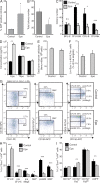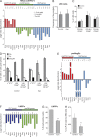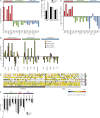Erythropoietin guides multipotent hematopoietic progenitor cells toward an erythroid fate
- PMID: 24493804
- PMCID: PMC3920567
- DOI: 10.1084/jem.20131189
Erythropoietin guides multipotent hematopoietic progenitor cells toward an erythroid fate
Abstract
The erythroid stress cytokine erythropoietin (Epo) supports the development of committed erythroid progenitors, but its ability to act on upstream, multipotent cells remains to be established. We observe that high systemic levels of Epo reprogram the transcriptomes of multi- and bipotent hematopoietic stem/progenitor cells in vivo. This induces erythroid lineage bias at all lineage bifurcations known to exist between hematopoietic stem cells (HSCs) and committed erythroid progenitors, leading to increased erythroid and decreased myeloid HSC output. Epo, therefore, has a lineage instructive role in vivo, through suppression of non-erythroid fate options, demonstrating the ability of a cytokine to systematically bias successive lineage choices in favor of the generation of a specific cell type.
Figures




Similar articles
-
Hematopoietic Stem Cells but Not Multipotent Progenitors Drive Erythropoiesis during Chronic Erythroid Stress in EPO Transgenic Mice.Stem Cell Reports. 2018 Jun 5;10(6):1908-1919. doi: 10.1016/j.stemcr.2018.04.012. Epub 2018 May 10. Stem Cell Reports. 2018. PMID: 29754961 Free PMC article.
-
Dual actions of Meis1 inhibit erythroid progenitor development and sustain general hematopoietic cell proliferation.Blood. 2012 Jul 12;120(2):335-46. doi: 10.1182/blood-2012-01-403139. Epub 2012 Jun 4. Blood. 2012. PMID: 22665933 Free PMC article.
-
Erythropoietin directly remodels the clonal composition of murine hematopoietic multipotent progenitor cells.Elife. 2022 Feb 15;11:e66922. doi: 10.7554/eLife.66922. Elife. 2022. PMID: 35166672 Free PMC article.
-
Erythro-myeloid progenitors: "definitive" hematopoiesis in the conceptus prior to the emergence of hematopoietic stem cells.Blood Cells Mol Dis. 2013 Dec;51(4):220-5. doi: 10.1016/j.bcmd.2013.09.006. Epub 2013 Oct 2. Blood Cells Mol Dis. 2013. PMID: 24095199 Free PMC article. Review.
-
Evolving insights into the synergy between erythropoietin and thrombopoietin and the bipotent erythroid/megakaryocytic progenitor cell.Exp Hematol. 2016 Aug;44(8):664-8. doi: 10.1016/j.exphem.2015.11.010. Epub 2016 Jan 8. Exp Hematol. 2016. PMID: 26773569 Free PMC article. Review.
Cited by
-
EpoR-tdTomato-Cre mice enable identification of EpoR expression in subsets of tissue macrophages and hematopoietic cells.Blood. 2021 Nov 18;138(20):1986-1997. doi: 10.1182/blood.2021011410. Blood. 2021. PMID: 34098576 Free PMC article.
-
PARP9 and PARP14 cross-regulate macrophage activation via STAT1 ADP-ribosylation.Nat Commun. 2016 Oct 31;7:12849. doi: 10.1038/ncomms12849. Nat Commun. 2016. PMID: 27796300 Free PMC article.
-
Molecular and cellular mechanisms that regulate human erythropoiesis.Blood. 2022 Apr 21;139(16):2450-2459. doi: 10.1182/blood.2021011044. Blood. 2022. PMID: 34936695 Free PMC article.
-
A Novel Combination Therapy of Erythropoietin and Thrombopoietin to Treat Erythropoietin-Resistance anemia.Pharm Res. 2022 Jun;39(6):1249-1265. doi: 10.1007/s11095-022-03304-z. Epub 2022 Jun 3. Pharm Res. 2022. PMID: 35661082
-
Population snapshots predict early haematopoietic and erythroid hierarchies.Nature. 2018 Mar 1;555(7694):54-60. doi: 10.1038/nature25741. Epub 2018 Feb 21. Nature. 2018. PMID: 29466336 Free PMC article.
References
-
- Adolfsson J., Månsson R., Buza-Vidas N., Hultquist A., Liuba K., Jensen C.T., Bryder D., Yang L., Borge O.J., Thoren L.A., et al. 2005. Identification of Flt3+ lympho-myeloid stem cells lacking erythro-megakaryocytic potential a revised road map for adult blood lineage commitment. Cell. 121:295–306 10.1016/j.cell.2005.02.013 - DOI - PubMed
-
- Bereshchenko O., Mancini E., Moore S., Bilbao D., Månsson R., Luc S., Grover A., Jacobsen S.E., Bryder D., Nerlov C. 2009. Hematopoietic stem cell expansion precedes the generation of committed myeloid leukemia-initiating cells in C/EBPalpha mutant AML. Cancer Cell. 16:390–400 10.1016/j.ccr.2009.09.036 - DOI - PubMed
Publication types
MeSH terms
Substances
Grants and funding
LinkOut - more resources
Full Text Sources
Other Literature Sources
Medical
Molecular Biology Databases
Research Materials

